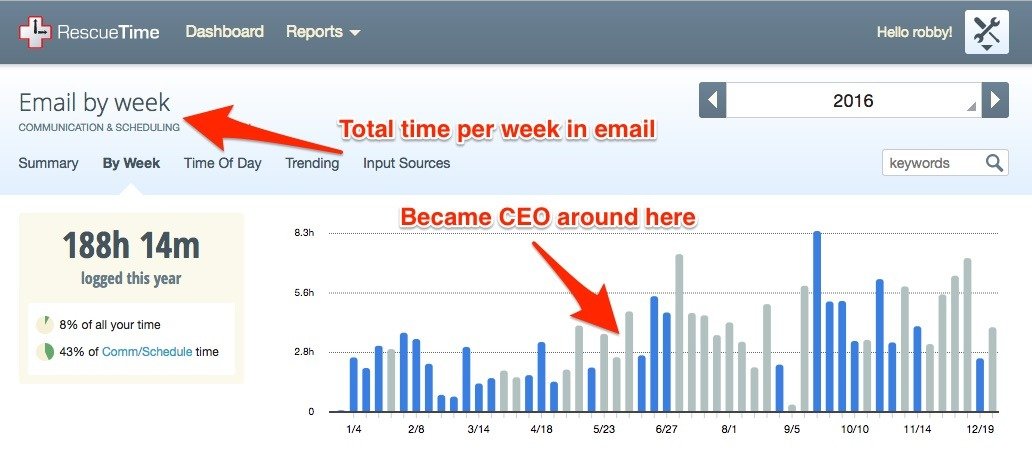I’ve looked at ways to write better emails in a past weekly roundup, but writing great emails isn’t always a good thing. The more great emails you write, the more replies you get. Being wonderful at writing emails could leave you with an overflowing inbox and no way to keep it in-check.
If your inbox is taking over your workday, try these tips to take back those wasted hours.
Use two separate inboxes
For web designer and developer Tania Rascia, the answer to keeping her inbox manageable has been to have two separate inboxes. Rascia has one “real” inbox that she checks regularly, and a separate one that she never looks at.
Rascia uses her second inbox for all the times an email address is required but she’s not interested in that mail. When a store asks for her email address, or she needs to use her email for something she doesn’t care about, Rascia uses this second address to ensure she’ll never see the mail she considers “junk”.
This keeps Rascia’s original inbox tidy and relevant:
I only use it to sign up for things that I will use very often or might be connected to payment in some way, and I immediately opt-out of all marketing. This is the only one I’ll get notifications for on my phone.
But if you want to use this approach, remember to send anything that might relate to payments to your personal inbox. For instance, if you sign up for a free trial of a service you don’t think you’ll use long-term, sending those emails to your junk inbox might mean you miss warnings when your free trial is almost up, and receipts when you start paying for a service you’re not even using.
Create a new inbox for yourself daily
Our CEO, Robby Macdonell, recently shared some of the ways he’s dealing with the extra communication responsibilities that come with being CEO. Email is one of Robby’s biggest communication struggles, as there’s inevitably more in the inbox than he can deal with in a day if he wants to get anything else done.

Robby’s solution is to use a label in Gmail to create a new inbox for himself each day. Once a day, Robby works through his inbox, adding the @processing label to any emails he wants to deal with that day. Then he hides everything else in his inbox. Robby says this makes email “a finishable task, rather than an ever-replenishing monster.”

Though a busy CEO like Robby can’t help but get more emails all day long, Robby says he’s found that nobody minds waiting a day or two for an email response. Ignoring anything that comes in after Robby’s created his inbox for the day means he can rest easy that his email task won’t grow throughout the day. And the following day, those new emails will get looked at as Robby creates a new @processing inbox to work through, so anything important will get handled within 24 hours anyway.
Accept the firehose (or, stop thinking you have to deal with every email you get)
Dan Mall, CEO of SuperBooked, used to limit how many RSS feeds he subscribed to. He felt each item from each feed had to be read, and he could only keep up with so much. But when Mall discovered Fever, an RSS reader that helped to surface the most popular posts among all his feeds, he was able to finally “accept the firehose”:
I was then free to add as many feeds as I wanted, as I figured the good stuff would make its way to me, not the other way around.
It wasn’t long before Mall changed his Twitter approach in the same way:
My strategy with Twitter was similar: where I used to keep the number of accounts I followed to a minimum so that I could keep up, I now follow whomever I want and figure the good stuff will make its way to me.
Mall was able to relax and enjoy getting news and information from RSS and Twitter by accepting the firehose—he no longer worried about reading every post or tweet, but relaxed in the knowledge that if something was truly important he’d hear about it.
But Mall points out that few of us tend to think about email in this way. We all assume that every message we get has to be dealt with, so for those of us with busy inboxes, our time is taken up by this obligation we’ve assumed for ourselves. Mall suggests we start thinking about email differently:
I think I’m ready to accept the email firehose. That means I’m making peace with the idea that I have more email than I can get to, and not all of it deserves my attention.
This is a more drastic approach than Robby’s method of working through a finite amount of emails each day. But if you take a critical look at the kind of emails you get each day and realize you’re spending time in your inbox that’s entirely unnecessary, Mall’s “accept the firehose” approach might be for you.
And if you’re really worried about what messages you might miss if you don’t treat every email as an important use of your time, you could mix in Rascia’s strategy of keeping separate inboxes with only the most important contacts having access to your main account.
How do you tame your inbox? Let us know in the comments.


I’ve been working on replying and archiving or scheduling required actions requested with all emails received around an hour before bed each night. I’m this able to literally empty my inbox every day. Nothing slips through the gaps and I sleep better. This has easily been my biggest productivity hack ever
Thanks for sharing, Ollie! Good to hear you’ve found a process that works reliably for you.